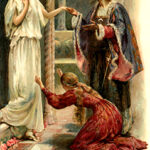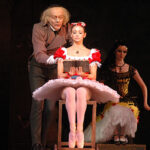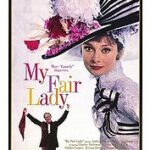Share This:
October 26, 2012 | Theatre,
The Transformation and Adaptation of Ovid’s Pygmalion
by Elizabeth Pashley
Whistler in the Dark’s production of Ted Hughes’ Tales from Ovid features several myths from Ovid’s classic Metamorphoses, as translated by Ted Hughes. It includes the tale of Pygmalion, which is about a sculptor who falls in love with his own statue.
Surrounded by cruel, wicked women, Pygmalion shuns all female interactions from his life and lives instead in solitary confinement. Yet one day he dreams of the perfect woman and decides to carve her figure in ivory. The statue looks so life-like that Pygmalion falls in love with her and wishes to marry her. Venus grants Pygmalion’s wish and the statue come to life.
This myth has been retold in many different forms, including plays, short stories, novels and films. Here are some of the most well-known (and some surprising) adaptations of Pygmalion:
The Winter’s Tale (1623) by William Shakespeare 
At the end of Shakespeare’s play, a statue of Queen Hermione comes to life and proclaims herself to be the real Hermione in a sort of deus ex machina reconciliation. While only a small part of the play involves the myth of Pygmalion, Shakespeare is notorious for using Ovid’s tales as the basis for his works, including Titus Andronicus and Romeo and Juliet (which is based off the myth Pyramus and Thisbe, a tale that also appears in A Midsummer Night’s Dream).
“The Birth-Mark” (1846) by Nathaniel Hawthorne
Hawthorne’s famous short story is about a philosopher and scientist who marries the perfect woman whose only flaw is a “port wine stain” birthmark on her cheek. Her husband, Aylmer, offers to concoct an elixir that will remove the birthmark and, wanting her husband’s approval, she agrees. The elixir works and for a moment, Georgiana appears flawless, but then she dies.
Coppélia (1974) choreographed by George Balanchine
This famous ballet centers around a doll created by Dr. Coppélius. A local townsgirl, Swanilda, breaks into the toy shop and, trying to hide from Dr. Coppélius, trades places with the doll. Meanwhile a townsboy, Franz, also breaks in because he has fallen in love with the beautiful life-like doll, who he thinks is real. Swanilda pretends to be the doll come to life until both Franz and Dr. Coppélius realize their error.
(continued)
Pygmalion (1912) by George Bernard Shaw
As the title suggests, George Bernard Shaw’s play Pygmalion centers around the Ovid myth and was adapted most famously into the movie and musical My Fair Lady. In the play, Henry Higgins, a professor of phonetics, bets that he can transform cockney flower girl, Eliza Doolittle, into a prim and proper woman. He succeeds, but not before falling in love with her.
Pretty Woman (1990) directed by Garry Marshall
In another adaptation of George Bernard Shaw’s Pygmalion, Julia Roberts and Richard Gear star in the hit movie Pretty Woman. The movie centers around a businessman, Edward Lewis, who needs an escort for social events and comes across a prostitute willing to do the job. He buys her a new wardrobe and she tries to learn how to fit into an upperclass society. It’s all business until Edward falls in love with his creation.
 Lars and the Real Girl (2007) directed by Craig Gillespie
Lars and the Real Girl (2007) directed by Craig Gillespie
In this indie movie, Lars brings home a sex doll that he orders off the Internet to his brother and sister-in-law’s house. But Lars isn’t interested in sex. Rather, he’s looking for a deep, meaningful relationship. His sister-in-law is worried for him, his brother thinks he’s nuts, but eventually the entire town goes along with his delusion in support of this sweet-natured boy that they’ve always loved.
Some information gathered through IMDB.







Leave a Reply